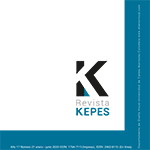Authors
Abstract
The Laureles neighborhood in Medellín, designed towards the thirties of the last century, is an urban-scale architecture that preserves the memory of the knowledge of the profession used in its execution. Even with the change of many original buildings, their characteristic features remain due to the clarity of the principles that governed the construction of the urban space, understandable through analytical approaches to apprehend and use them in new interventions. That is the reason for the selection of several locations in the neighborhood, in different places in the blocks like in middle sections and on the corners, for a controlled substitution of current buildings with architectural structures for collective activities, as part of a design course at the School of Architecture of Universidad Nacional de Colombia, Medellín Campus. This work is part of several approaches aimed at consolidating a research model, one among many possible models, focused on some implicit conceptual instruments when designing architecture which are frequently practiced in an unconscious way without clear verbalization so that the aim is to raise them to consciousness in the thinking of the apprentices of the profession through experiments designed to specify examples of these notions and verify their usefulness. To expose the general meaning of the principles addressed, some projects are redrawn and arranged in graphic tables that allow their simultaneous view. While the relationships are presented successively, notions become intelligible and the constructed knowledge is transmissible in written texts. The main objective of this work was to experiment on the transformation of an urban architecture by controlled substitution of some pieces starting from the analysis of its principles, modifying some relationships and conserving others. Methodologically, different strategies were implemented to organize the architectural and urban spaces relating them in the building study of the volume of shapes where architecture acquires constructive authenticity.
References
Da Graça, C. (2015). Centro Cultural de Belém, Lisboa [Catálogo de exposición / Marta Sequeira y Susana Rato Eds.], Oporto: Dafne.
Frampton, K. (1999). Estudios sobre cultura tectónica (Vol. 22). España: AKAL.
Gaviria, M. y Hernández, L. (2015). El proyecto arquitectónico como transformación. Sustitución, rehabitación, adición, Medellín, Editorial UN.
Gaviria, M. y Hernández, L. (2017). Arquitecturas ejemplares en Medellín. Sobre proyecto y análisis, Medellín, Editorial UN.
Graus, R. (2005). La cubierta plana, un paseo por su historia. Barcelona: Universitat Politècnica de Catalunya, Texsa.
González, L. (2014). Pedro Nel Gómez: el maestro: arquitecto-urbanistapaisajista. Medellín: Universidad Nacional de Colombia Sede Medellín, Facultad de Arquitectura.
Kepes, G. (1951). Language of Vision. Chicago: Theobal.
Koolhaas, R. (2000). Transformations. OMA@work.a+u, A+U, 2000: 106-155 Le Corbusier. (1923). Vers une architecture. París: Cres.
Le Corbusier. (1946). ,“L’espace indicible”, en L’Architecture d’Aujourd’hui, abril 1946, pp. 9-17.
Martí Aris, C. (2005). La cimbra y el arco. Barcelona: Fundación Caja de Arquitectos.
Moneo, R. (1985) La vida de los edificios: las ampliaciones de la Mezquita de Córdoba. Madrid: COAM.
Monteys Roig, X. (2012). REHABITAR en nueve episodios. Madrid: Lampreave.
Rowe, C y Slutzky, R. (1968). Transparencia: Literal y Fenomenal. Basilea: B. Hoesli.
Russo, M. (2017). Topos, Typos, Tekton. L’appropriata collocazione delle cose. F A Magazine. Ricerche e progetti sull’architettura e la città, 39, 49-56.
Rueda, Ó. y Pizarro, M.J. (2013). Bekleidung: Gottfried Semper y la técnica textil como origen de la envolvente en la arquitectura. DC Papers, 25-26.
Sarmiento, J. (2017). Maquetas y prototipos como herramientas de aprendizaje en arquitectura. AU Arquitectura y Urbanismo, 38(2), 43-52.
Semper, G. (2013). Semper: el estilo: El estilo en las artes técnicas y tectónicas, o, Estética práctica y textos complementarios. Buenos aires: Azpiazu.
Trías de Bes, F. (2008). La disección de la rana. El País Semanal, domingo 3 de febrero. p. 28.
Valencia, J. (2018). Plataforma desmaterializada en la casa Farnsworth. Operación moderna estereotómica. Revista de Arquitectura (Bogotá), 20(1), 53-61. doi: http://dx.doi.org/10.14718/RevArq.2018.20.1.91
Varón, T. y Morales, L. (1998). Árboles del Valle de Aburrá. Medellín: Área Metropolitana del Valle de Aburrá.
Velez, C., López, L., Gaviria, M. y Montoya, N. (2010). Arquitectura Moderna en Medellín 1947-1970. Medellín: Universidad Nacional de Colombia.

 PDF (Español)
PDF (Español)
 FLIP
FLIP





















